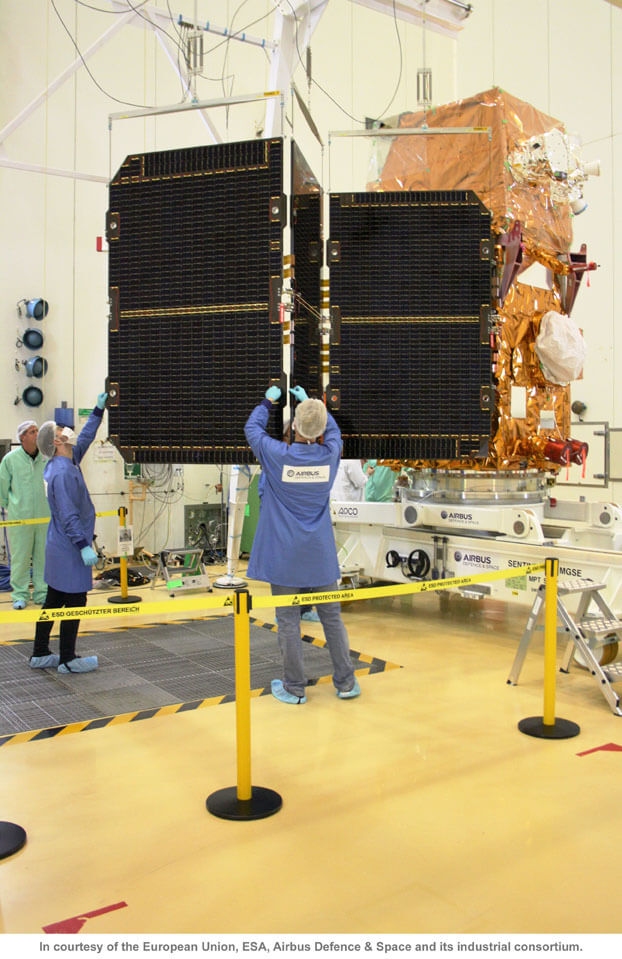Engineers Prepare New EU Climate Satellite’s Solar Panels For Launch
Engineers preparing the launch of Europe’s new climate data satellite say they have made improvements to its solar panels.
While the satellite was being readied for liftoff at Europe’s spaceport in French Guiana, engineers discovered and fixed a number of issues with its solar array.
The satellite is scheduled to be the latest in a series of new satellites launched by the European Space Agency (ESA) to expand the EU’s environmental monitoring capacity.
ESA says that despite the unexpected work the launch is still on schedule and liftoff remains “green” for 7 March at 1:49 GMT (2:49 CET or 22:49 local time on 6 March).
Named Sentinel-2b, the satellite will add new spectral and high-resolution capabilities to Europe’s earth observation fleet and will beam down crucial data on the state of the planet’s vegetation and forests, as well as information about pollution in lakes and oceans.
The satellite, which will be put in orbit by an Italian Vega rocket, will also monitor glaciers, sea ice and snow cover.
Solar Array
To power its electrical systems the satellite needs 1700 watts of electricity for which it will rely on a 7.2 square metre solar array and a 87 ampere hour (Ah) battery.
ESA says engineers found that “two types of the solar array connectors didn’t come up to scratch so needed to be carefully inspected and cleaned.”
In order to do this, engineers had to expand the satellite’s solar array which had already been folded up to fit in the Vega rocket.

Engineers work on Sentinel-2b’s solar array.
“We also exchanged a Coarse Earth and Sun Sensor Head (…) This was because the glass cover was found to be partially broken,” Sentinel-2 project manager Francois Spoto told ESA.
“These unexpected activities meant bringing in some equipment and a number of experts from Europe, from Airbus Defence and Space in the Netherlands and Germany,” Spoto said.
Finalised in the Netherlands at the European Space Research and Technology Centre, the Sentinel-2b satellite is the product of collaboration across the continent.
“It’s a European satellite, built by more than 60 contractors from 15 countries,” Michael Menking from Airbus, the primary contractor leading the industrial consortium, told ESA.
Earth Observation
The Sentinel satellite will join the four European earth observation satellites already in orbit. The full Sentinel constellation, operated by the European Commission, is expected to be completed in 2021.
Together with its identical twin Sentinel-2a, launched in 2015, the new satellite will cover the entire world every five days. The two satellites have been designed with the agricultural and forestry sectors in mind as key data users.
Climate data: Europe expands its fleet of #Copernicus #Earthobservation satellites #Sentinel2 https://t.co/EW0gZDB4vr @ClimateKIC
— Copernicus EU (@CopernicusEU) January 15, 2017
In addition to monitoring plant growth and forest health, the satellite’s images of floods, volcano eruptions, forest fires and landslides are expected to help humanitarian relief efforts.
Once completed, the full Sentinel programme will count six pairs of satellites. The weather-monitoring Sentinel-1 mission has already been fully operational since last year and the first of two Sentinel-3 climate and ocean monitoring satellites was also put into orbit in 2016.
@ClimateKIC and #Copernicus are teaming up to accelerate use of EU #satellitedata for #climateactions https://t.co/3PetGD2SPk
— Copernicus EU (@CopernicusEU) May 1, 2016
Open Data
Additional satellite launches over the next five years will focus on providing more atmospheric and sea-level monitoring data to the European Union’s Copernicus earth observation programme.
The Sentinel satellites send their land, ocean and atmospheric data and imagery to Copernicus, and the EU says it wants to make it easier for innovative companies and start-ups to access the data.
Last year, it was announced that Copernicus is teaming up with Climate-KIC, the European Union’s climate innovation initiative, to accelerate the use of its data in creating climate change solutions.
“The free and open data policy is one of the key achievements of Copernicus, and is also the key to its success,” Andras Roboz of the European Commission’s Copernicus unit told ESA.
Interested in the business opportunities of climate data? Find out about Climate-KIC’s programmes for students and start-ups.

